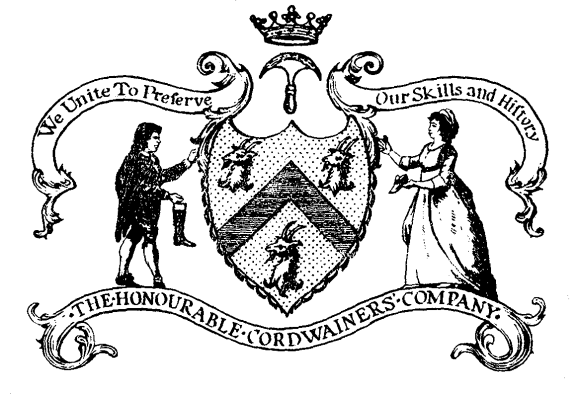

The term "Cordwainer" is an Anglicization of the French word cordonnier, introduced into our language after the Norman invasion of England in 1066. The word itself is derived from the city of Cordoba, in the south of Spain, a stronghold of the mighty Omeyyad Kalifs until its fall in the 12th century. Moorish Cordoba was celebrated for two staple trades in the early Middle Ages, silversmithing and the production of cordouan(cordovan)leather, called "cordwain" in England. Originally made from the skin of the Musoli goat, then found in Corsica, Sardinia, and elsewhere, this leather was "tawed" with alum after a method supposedly known only to the Moors. English Crusaders brought home much plunder and loot, including the finest leather the English shoemakers had ever seen. Gradually cordouan, or cordovan leather became the material most in demand for the finest footwear in all of Europe.
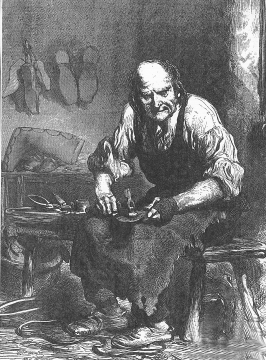 The English term cordwainer, meaning shoemaker, first appears in 1100. By the late 13th century a distinction grew in England between Cordwainers. proper, called alutari, who used only alum "tawed" cordwain, and another class of shoemakers called basanarii, who employed an inferior "tanned" sheepskin which was prohibited for footwear apart from long boots. Since this period the term cordouan, or cordovan leather, has been applied to several varieties of leather. Today cordovan leather is a "vegetable tanned" horse "shell," and like the Medieval cordwain is used only for the highest quality shoes.
The English term cordwainer, meaning shoemaker, first appears in 1100. By the late 13th century a distinction grew in England between Cordwainers. proper, called alutari, who used only alum "tawed" cordwain, and another class of shoemakers called basanarii, who employed an inferior "tanned" sheepskin which was prohibited for footwear apart from long boots. Since this period the term cordouan, or cordovan leather, has been applied to several varieties of leather. Today cordovan leather is a "vegetable tanned" horse "shell," and like the Medieval cordwain is used only for the highest quality shoes.
Since the Middle Ages the title of Cordwainer has been selected by the shoemakers themselves, and used rather loosely; however, generally it always refers to a certain class of shoe and boot-makers. The first English guild of shoemakers who called themselves "Cordwainers" was founded at Oxford in 1131. "Cordwainers" was also the choice of the London shoemakers, who had organized a guild before 1160, and the Worshipful Company of Cordwainers has likewise used this title since receiving their first Ordinances in 1272.
The first "Cordwainers," or shoemakers, to arrive in America came to Jamestown, Virginia, the first permanent English settlement in this continent established in 1607. Captain John Smith, an alleged Cordwainer himself, was first among the leaders of the settlement, from which began the overseas expansion of the English speaking peoples as the earliest outpost of the British Empire, and the first beginnings of the United States of America. Captain Smith's historic adventure of settlement was, in part, supported by profits made in the English shoe trade, but to what degree we do not know.
Shoemakers, tanners, and other tradesmen had arrived in Jamestown by 1610, and the Secretary of Virginia had recorded the flourishing shoe and leather trades there as early as 1616. The first shoemaker to arrive in America, whose name has been preserved, was Christopher Nelme, who had sailed from Bristol, England and arrived in Jamestown in 1619. Nearly one year later, when the first Pilgrim settlers landed in Massachusetts, they relied upon the colony in Virginia for vital commodities and when the first shoemakers arrived there, in 1629, it is likely that they survived in part on the Virginia leather until their own tanners were established. Throughout the late 17th century, Virginian exported her leather to New England, initially supplying the shoe trade which boomed there after the 1760's.
One distinction preserved by Cordwainers since the earliest times is, that a Cordwainer works only with new leather, where a Cobbler works with old. Cobblers have always been repairers, frequently prohibited by law from actually making shoes. Even going so far as to collect worn-out footwear, cut it apart, and remanufacture cheap shoes entirely form salvaged leather, Cobblers have contended with Cordwainers since at least the Middle Ages. In 16th century London the Cordwainers solved their conflicts with the Cobblers of that city by placing them under the powerful authority of the Cordwainer's guild, thus merging with them.
Whenever shoemakers have organized, they have shown a clear preference for the title "Cordwainer," conscious of the distinguished history and tradition it conveys. Today's Cordwainer is no exception. The current generation of shoemakers includes a growing number of self-employed tradesmen and women, who having largely adopted early hand-sewn techniques supplemented by only a few simple machines out of economic necessity, continue to practice the traditional skills established centuries ago. In the face of declining domestic footwear production every year, it can be easily said that the future of this trade is being insured by the skilled hands of these modern Cordwainers.
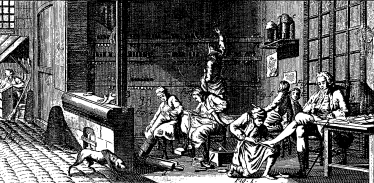 Founded in 1984 by a small group of shoemakers and historians, the H.C.C. is a modern guild, having drawn up its charter in 1985. In 1987 we were honored by being granted the recognition of The Worshipful Company of Cordwainers, established in London, England in 1272. In 1987 the HCC also incorporated as a non-profit, tax-exempt educational organization in the state of Virginia, the home of America's first shoemakers. The HCC is a steadily growing international membership of men and women, actively discovering and preserving the practical skills, technology and history of shoemaking and its allied trades. Our diverse membership is composed of: practising shoemakers; historical shoemaking interpreters and museum animators; researchers; traditional leather workers; shoe repairers; large and small scale manufacturers; museum personnel; archaeologists; economic labor and industrial historians; trade history scholars; costume specialists; tool and machinery collectors; authors; educators and students, from the United States, Canada, Great Britain and Europe.
Founded in 1984 by a small group of shoemakers and historians, the H.C.C. is a modern guild, having drawn up its charter in 1985. In 1987 we were honored by being granted the recognition of The Worshipful Company of Cordwainers, established in London, England in 1272. In 1987 the HCC also incorporated as a non-profit, tax-exempt educational organization in the state of Virginia, the home of America's first shoemakers. The HCC is a steadily growing international membership of men and women, actively discovering and preserving the practical skills, technology and history of shoemaking and its allied trades. Our diverse membership is composed of: practising shoemakers; historical shoemaking interpreters and museum animators; researchers; traditional leather workers; shoe repairers; large and small scale manufacturers; museum personnel; archaeologists; economic labor and industrial historians; trade history scholars; costume specialists; tool and machinery collectors; authors; educators and students, from the United States, Canada, Great Britain and Europe.
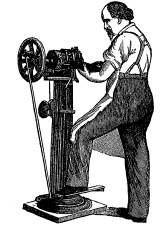 Currently we provide a forum for the exchange of technical expertise, research, training, and material needs such as tools, supplies, and sources for goods and services among our members. The HCC also acts as a public clearinghouse for related research, educational resources, and professional services by members in their various fields of expertise, as well as through the support of educational activities such as: independent research projects; publications; demonstrations of historic shoemaking; tool and artifact exhibits; and special practical workshops.
Currently we provide a forum for the exchange of technical expertise, research, training, and material needs such as tools, supplies, and sources for goods and services among our members. The HCC also acts as a public clearinghouse for related research, educational resources, and professional services by members in their various fields of expertise, as well as through the support of educational activities such as: independent research projects; publications; demonstrations of historic shoemaking; tool and artifact exhibits; and special practical workshops.
Members receive special benefits, including: a membership directory; The Crispin Courier a quarterly newsletter; special events notification; discounts on recently published works of interest; access to the purchase of HCC re-printed textbooks on historic shoemaking and allied trades; and group purchases of hard-to-find materials.
The Guild also maintains a technical library, and annually produces and distributes educational videos of guild lectures, workshops and demonstrations from the yearly meetings. In addition, the Guild is currently launching a new 'Journal' of more in-depth topics of interest on the subject of boot and shoemaking.
The HCC hold as annual meeting over the weekend closest to the 25th of October (St. Crispin's Day), usually at a site of historic interest. This meeting includes a general business meeting, and various educational presentations and lectures by members and special guest, as well as an exhibition of members' work, tools and items for sale or trade to fellow members.
he establishment of a public museum, exhibiting both historic footwear and trade artifacts, which tells the story of shoes and shoemaking in the United States. In addition to a permanent collection, selected "prize work," antique footwear, and tools and machines loaned by HCC members will give singular access to the vast wealth of rare and fine artifacts in members' private collections otherwise unavailable for public study. This museum will include a reference library as well, containing research materials and historic texts, making the HCC museum an unparalleled center for students to draw upon the collective expertise of our membership. Special projects are planned to include programs for field archaeologists, conservators, and preservationists concerned with old leather objects. An educational training center for practical shoemaking in its various aspects, the production of multimedia educational material, and the dissemination of current research all head the list of our plans for the future.
On a more immediate basis, the guild shoe collection will be on exhibit at Gustafson Gallery, CO State U in '99 [a video catalogue of the collection was made at this year's AGM and will soon be available to members]
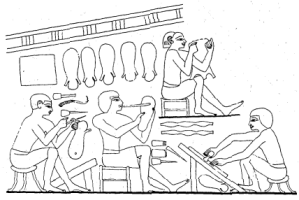
The arms of The Honourable Cordwainers' Company (displayed on the title page) were initially derived from the arms granted to The Worshipful Company of Cordwainers, circa 1579. These armorials were in turn adapted by The Friendly Society of Cordwainers of England, circa 1784, The Union Society of Cordwainers of the City & Liberties of Philedelphia, circa 1790, and again adapted by the Honourable Cordwainers' Company in 1986. The cresent shaped "round knife" appears in the arms of the Edinburgh Cordwainers, circa 1780, and is displayed by us as a symbol of unity with all the leather trades, many having used this form of knife since the Egyptian Dynasties. the male and female supporters proclaim the mutual roles played by both sexes in our trade since the earliest times. The colors of The Honourable Cordwainers' Company are azure (blue) and gold, proudly adopted out of respect for The Worshipful Company of Cordwainers, who have used these colors in their armorials for many centuries.
Below are displayed some historic arms from both England and France.
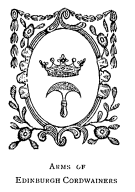 |
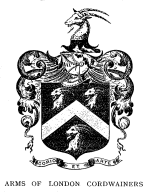 |
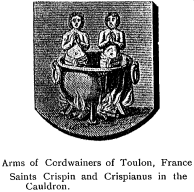 |
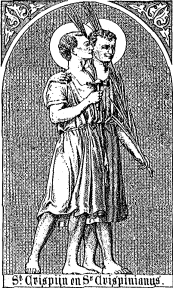
Shoemaking has a long history and one that is rich in tradition. Within the trade itself--among shoe and bootmakers--the legends, the traditions, and the history really begin with St. Crispin. St. Crispin is the patron saint of shoemakers. Since medieval times, October 25th has been celebrated as St. Crispin's Day and the Shoemaker's Holiday. In the past, boot and shoemakers traditionally closed their shops on this day, in celebration and commemoration. I say commemoration because there is more to the story of St. Crispin than meets the eye. Actually there are two stories that seem to be the same...one in England, one in France. St. Crispin was born into a wealthy Roman family in the third century A.D.. Somewhere fairly early on, he converted to Christianity. Since this was not an approved lifestyle for a noble Roman, legend says that he was disinherited. Forced to fall back upon his own resources, St. Crispin (not yet a saint) became a shoemaker. Although teaching the gospel was his life's work, he made shoes in his spare time--until he was put to death for his beliefs in Soissons, France in 288 A.D..
Sir Hugh, the English counterpart to St. Crispin lent his name to the shoemaker's kit of tools. Born a Prince of Btritain and son of Arviragus--King of Powisland (modern day Wales), St. Hugh married a Christian princess, Winifred of Flintshire. She quickly converted him to Christianity, with roughly the same results. Thrown into poverty after losing all his wealth in a shipwreck, Hugh became a shoemaker who preached the gospel by day and plied his craft by night. Both he and Winifred were put to death, ostensibly for rabble-rousing, about 300 A.D.. Legend has it that his fellow shoemakers kept constant vigil and consoled him during the time of his internment. In gratitude Hugh bequeathed his only possession--his, body, his bones--to his comrades. After his death, by poison and then by hanging, his friends pulled his body from the gibbet and dried his bones. These were made into tools for making shoes. For many years, in fact, a shoemaker's tool kit was called St. Hugh's Bones.
Membership in The Honourable Cordwainers' Company is open to anyone who actively supports the goals and interests of this organization.
| Membership Regular Membership Institutional Membership Family Membership Donor Sponsor Patron Tax-deductible Donation:______________ |
Yearly Fee (U.S. Funds) |
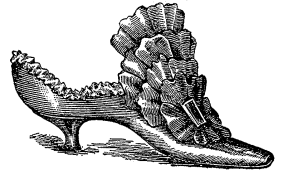
H.C.C. LIBRARY:
The following titles are available to the public as well as to Guild members. Members receive a discount on all titles.
[The Guild also has a library of rare books and materials not listed here. This is not a "lending" library. But members may seek information from these books through the Guild "librarian."]
(contact the sitemaster for more information)
HCC Videos - Videos of Papers Presented at Past Gatherings of the Company--Member Prices $29.95 + $6.00 S&H
Vol I
Historic Shoemaking - June Swann
Vol II
Military shoes, 1911-1915 - Captain Earnest Peterkin
modern Manufacture, Pinnacles and Pitfalls - Larry waller
Vol III
Anatomy of Archaeological Shoes - Al Saguto
Vol IV
Conducting a Shoemaking Workshop - Peter Oakley
Operating a Sucessful Shoemaking Shop - Dan Freeman
Vol V
US Army Bootee, 1861-1865 - Captain Earnest Peterkin
Shoemakers at Work - Al Saguto
Vol VI
Shoemaking by the Book - Al Saguto
Hessian, Hussar, Hungarian Boots - June Swann
The Leather And Tanning Museums of France - Rene Hackstetter
Vol VII
Making a 19th Century Peg Shoe - Peter Oakley
Vol VIII
Shoes From columbas to the Present - June Swann
The shoemaking Industry in Early 19th Century Massachusetts - Peter Oakley
A look at Two 18th Century Shoemakers - Paul Lurk
Vol IX
Shoemaking From Historical Sources: Preserving A Process as an Artifact - Al Saguto
A Visit to the Shoe shop at Plimoth Plantation - Rusty Moore
Military Accouterments of the 4oth Regiment of Grenadiers - Tim Wilson
Reprints - Photocopied books and chapters from books that are in the public domain but so rare as to be otherwise unavailable
1) Rees, John F., The Art and Mystery of A Cordwainer, London, 1813. 153 pages, 3 plates. the earliest known technical book on shoemaking in English.
Member price $15.00
2) Devlin, James D., The guide to the Trade, the Shoemaker, London, 1839/40. 288 pages, with numerous illustrations (Vol.I &II bound together). Victorian shoemaking and the duties of master, journeyman, etc. covered in good detail.
Member price $30.00
3) Leno, John Bedford, The Art of Boot and Shoemaking, London, 1895. 247 pages, numerous illustrations and diagrams. Shoemaking, as well as repairing well covered, plus early machinery.
Member price $20.00
4) Baker, Oliver, Black Jacks and Leather Bottles, Cheltenham, 1921. 197 pages, copiously illustrated with pen and inks, photos and half-tones. The only standard work known on leather drinking vessels, their making and history.
Member price $40.00
5) O'Sullivan, John, The Art and Mystery of the Gentle Craft, London, 1834. 57 pages, one plate. A fore-shortened version of Rees, with updated styles and patterns in the plate, and the addition of various receipts.
Member price $15.00
6) Hasluck, Paul N., Bootmaking and Mending, London, 1895. 166 pages, numerous illustrations and diagrams. Excellent descriptions of hand-sewn making and repair, shows many tools.
Member price $20.00
7) Golding, Frank Y., (ed.) Boots and Shoes, Their Making..., London, 1935. Excerpts from Section XVI, 'Measuring And Obtaining Data From The Foot'. Well illustrated step by step guide discussing the early-modern approach.
Member price $20.00
8) Golding, Frank Y., (ed.) Boots and Shoes, Their Making..., London, 1935. Excerpts from Section XII, 'Hnadsewn Bootmaking'. Photos and diagrams of processes well described - the making of traditional men's welted shoes.
Member Price $20.00
![]() Cordwainers College"The Cordwainers College is a world centre of excellence for education, training, research and consultancy. The college aims to be a global provider of services in design, technology, production and management for the footwear, fashion accessories, art and design, leathergoods, saddlery and allied industries."
Cordwainers College"The Cordwainers College is a world centre of excellence for education, training, research and consultancy. The college aims to be a global provider of services in design, technology, production and management for the footwear, fashion accessories, art and design, leathergoods, saddlery and allied industries."
![]() Footwear in the Middle Ages....an interesting and detailed overview of construction techniques for recreating medieval footwear
Footwear in the Middle Ages....an interesting and detailed overview of construction techniques for recreating medieval footwear
![]() Venetian Chopines An on-line research paper by Elizabeth Bernhardt, a grad student at the University of Toronto.
Venetian Chopines An on-line research paper by Elizabeth Bernhardt, a grad student at the University of Toronto.